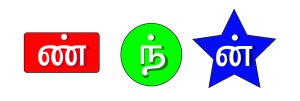பட வார்த்தைகள்
சிறு குழந்தைகள் ஒரு மொழியில் படிக்க ஆரம்பிக்கும் போது எழுத்துக் கூட்டி படிக்க ஆரம்பிப்பதற்கு முன்னால் ஒரு சில சொற்களை படங்களாக மனதில் பதிய வைத்துக் கொள்வது நல்லது. ஒரு சொல்லை மனதில் கண்ணால் படம் பிடித்து மூளைக்குள் நிறுத்தி விட்டால் அவர்கள் சிறு வாக்கியங்களை விரைவிலும் எளிதாகவும் வாசிக்கக் கூடும் . அதனால் அவர்களின் தன்னம்பிக்கை பெருகும். இந்த முறையை ஆங்கில மொழியில் கண்டு பிடித்தவர். Edward William Dolch. இவர் 1948 ஆம் ஆண்டு இதை “Problems in Reading” என்ற தன் புத்தகத்தில் எழுதியுள்ளார். அப்படி அவர் எழுதிய ஆங்கில சொற்களை ஒட்டி எழுதப்பட்ட சிலதமிழ் சொற்கள் இங்கே கொடுக்கப்பட்டுள்ளன.
- அங்கே
- அது
- அப்பா
- அம்மா
- அவர்
- அவள்
- அவன்
- ஆண்
- இங்கே
- இது
- இவர்
- இவள்
- இவன்
- உள்ளே
- உன்
- எங்கே
- எடு
- எது
- எலி
- எவர்
- எவள்
- எவன்
- என்
- என்ன
- ஏன்
- கீழே
- குதி
- கை
- கொடு
- சிறியது
- தை
- நட
- நாய்
- நான்
- நீ
- படி
- பாடு
- புலி
- பூனை
- பெண்
- பெரியது
- போ
- மேலே
- யார்
- யானை
- வா
- விடு
- வீடு
- வெளியே
- வை
Sight words
Sight words are frequent words that the children keep them in their memory thus starting to read sentences faster. This concept was introduced by Edward William Dolch in 1948 through his book “Problems in Reading”. These Tamil words are created on the basis of his list.
- அங்கே(angay)- there
- அது (athu)=that
- அப்பா(appaa)-father
- அம்மா(ammaa) – mother
- அவர் (avar)- he with respect
- அவள்(avaLL)-she
- அவன்(avan)- he
- ஆண் (aaNn)-male
- இங்கே(ingay) -here
- இது(ithu)-this
- இவர் (ivar)-he who is closer
- இவள்(ivaL)-she who is closer
- இவன் (ivan)-he who is closer
- உள்ளே(wuLLay)-inside
- உன் (un)-you
- எங்கே (engay) -where
- எடு(edu)-take
- எது (ethu) -which
- எலி(eli)-rat
- எவர் (evar)-who
- எவள் (evaLL)who female form
- எவன்(evan) –who male form
- என்(yen)-mine
- என்ன(enna)-what
- ஏன் (ayen)-why
- கீழே (keezhay)- down
- குதி (kuthi) -jump
- கை (kai)-hand
- கொடு (kodu)-give
- சிறியது(ciRiyathu)=small
- தை(thai)-sew
- நட (nada)-walk
- நாய்(naai)-dog
- நான்(naan)- me
- நீ (nee)-you
- படி (paddi)-read
- பாடு (paadu)-sing
- புலி(puli)-tiger
- பூனை(puunai) -cat
- பெண்(peNn)-female
- பெரியது(perriyathu)-big
- போ (pohh)-go
- மேலே (maylay)-up
- யார்(yaar)-who
- யானை (yaanai)-elephant
- வா(vaa) – come
- விடு(vidu) –let go
- வீடு (veedu)-house
- வெளியே (veLLiyay) -outside
- வை (vai)-put



















You must be logged in to post a comment.